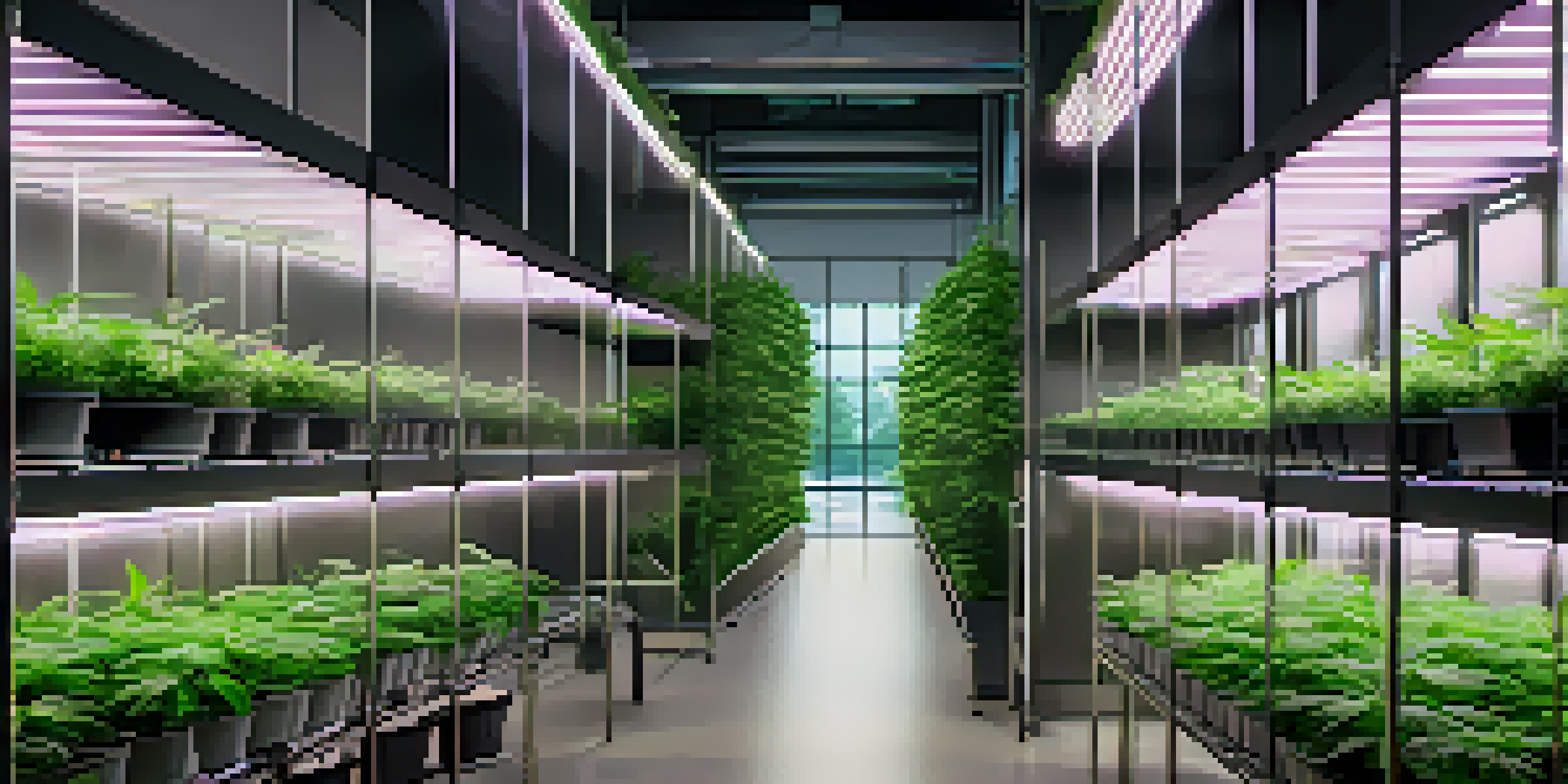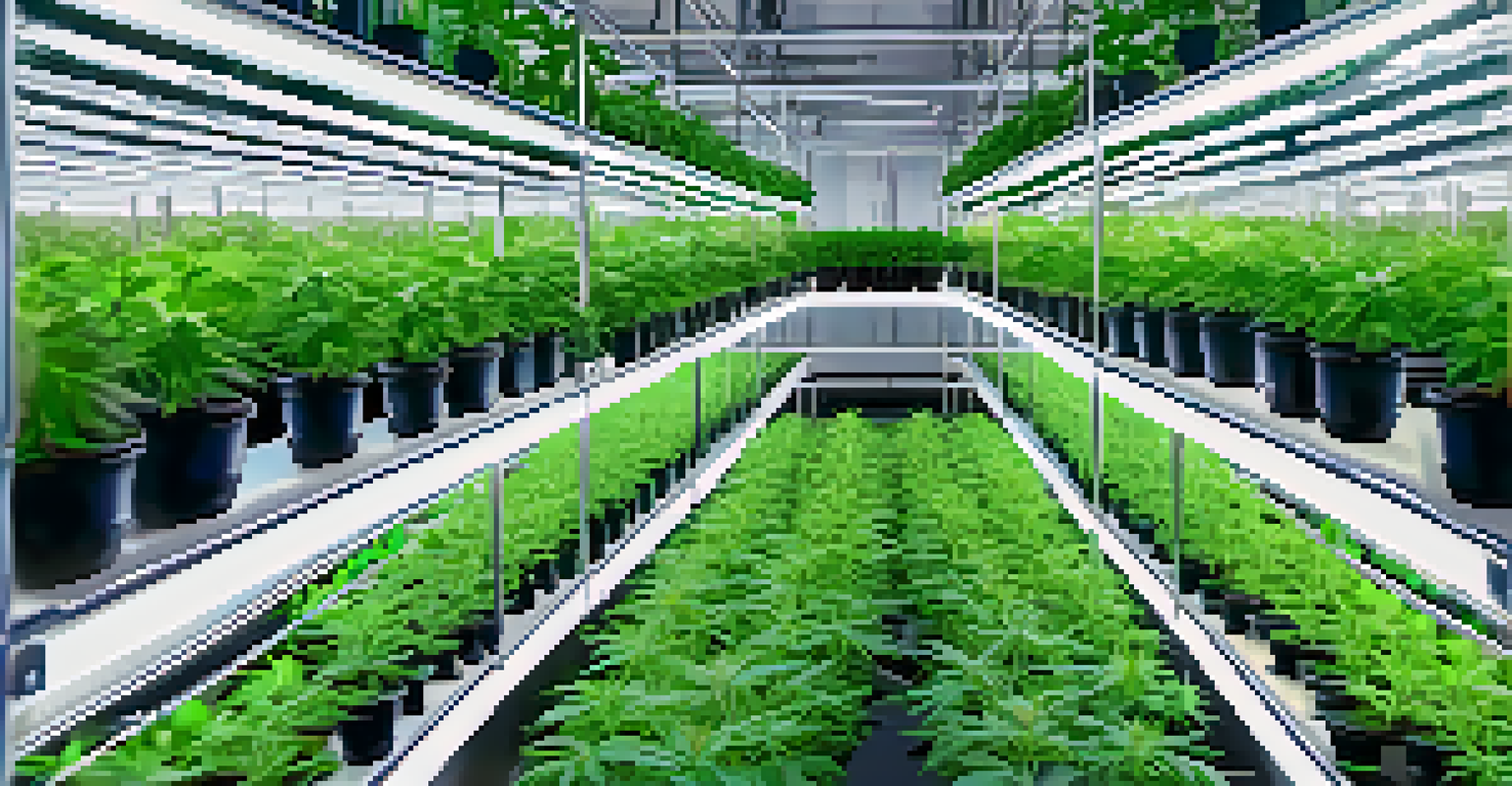Vertical Farming: Innovations in Cannabis Cultivation

Understanding Vertical Farming in Cannabis Cultivation
Vertical farming is a modern approach that maximizes space by stacking crops vertically. This technique is particularly beneficial in urban areas where land is scarce. By utilizing controlled environments, vertical farms can grow cannabis year-round, independent of weather conditions.
Vertical farming is not just a solution for food production; it’s a way to rethink how we approach agriculture in urban environments.
One of the key advantages is that vertical farms can significantly reduce the carbon footprint associated with traditional farming. They use less water and eliminate the need for harmful pesticides, creating a more sustainable product. Additionally, the ability to monitor growth conditions closely leads to healthier plants and higher yields.
The combination of technology and agriculture in vertical farming is transforming how we think about cultivation. For cannabis growers, this means better quality control and the potential for a more consistent product. As the industry evolves, vertical farming is becoming an essential aspect of modern cannabis cultivation.
Technological Innovations Enhancing Vertical Farming
At the heart of vertical farming are advanced technologies like LED lighting, hydroponics, and automation. LED lights provide the perfect spectrum for plant growth while consuming less energy compared to traditional lighting. This innovation not only saves money but also supports healthier plant development.

Hydroponics, the method of growing plants in nutrient-rich water without soil, is particularly well-suited for vertical farming. This approach allows for quicker growth cycles and more efficient nutrient delivery. For cannabis cultivators, it means maximizing yield in a shorter time frame.
Vertical Farming Boosts Sustainability
By reducing land use and minimizing water and pesticide consumption, vertical farming makes cannabis cultivation more eco-friendly.
Automation plays a crucial role in managing these high-tech farms. From monitoring plant health with sensors to automating nutrient delivery, technology streamlines the entire cultivation process. This reduces labor costs and minimizes human error, leading to a more productive growing environment.
Economic Benefits of Vertical Cannabis Farming
The economic impact of vertical farming on cannabis cultivation is significant. By optimizing space and resources, growers can produce more cannabis in less time and at a lower cost. This efficiency translates into better profit margins and a more competitive market position.
Sustainability isn't just a trend; it's a fundamental shift in how we grow and consume, ensuring we leave a better world for future generations.
Moreover, vertical farms can operate in urban settings, reducing transportation costs and improving product freshness. As consumers increasingly prefer locally sourced products, this proximity to market can lead to increased sales. The potential for direct sales to consumers also opens up new revenue streams.
Investing in vertical farming technology may require upfront capital, but the long-term savings and increased revenue potential make it a smart choice for cannabis cultivators. As the market grows, those who adopt these innovative practices will likely lead the industry.
Sustainability: A Core Principle of Vertical Farming
Sustainability is a crucial aspect of vertical farming that resonates with today's environmentally conscious consumers. By reducing land use and minimizing water consumption, vertical farms make cannabis cultivation more eco-friendly. This aligns with the values of many cannabis users who prioritize sustainable practices.
The controlled environments of vertical farms also lead to lower pesticide usage, fostering healthier plants and cleaner products. This reduction in chemical use not only benefits consumers but also the environment, as fewer harmful substances enter our ecosystems.
Tech Innovations Drive Efficiency
Advanced technologies like LED lighting and hydroponics enhance growth cycles and streamline operations for cannabis growers.
As the cannabis industry faces increasing scrutiny regarding its ecological impact, vertical farming offers a viable path forward. Emphasizing sustainability can help attract customers who are looking for responsible choices in their cannabis products.
Challenges Facing Vertical Cannabis Farming
Despite its many benefits, vertical farming for cannabis cultivation is not without challenges. High initial setup costs can deter some growers from adopting this method. Investing in advanced technology requires careful financial planning and consideration of long-term gains.
Additionally, the technical knowledge required to run a vertical farm can be a barrier for new cultivators. Understanding the nuances of hydroponics, lighting, and automation systems is essential for success. Training and education are critical components that can help bridge this knowledge gap.
Lastly, regulatory hurdles in the cannabis industry can complicate the implementation of vertical farming. Navigating local laws and regulations while trying to innovate can be a daunting task. However, with careful research and planning, these challenges can be managed effectively.
Future Trends in Vertical Cannabis Farming
Looking ahead, several exciting trends are emerging in vertical cannabis farming. One significant trend is the integration of artificial intelligence (AI) to optimize growing conditions. AI can analyze data from sensors to make real-time adjustments, ensuring that plants receive the ideal environment for growth.
Another trend is the development of more sustainable practices within vertical farming. Innovations in renewable energy sources, such as solar panels, can further reduce the carbon footprint of cannabis cultivation. This aligns with the increasing demand for eco-friendly practices in agriculture.
Community Engagement Strengthens Bonds
Building connections with local communities fosters trust and promotes responsible cannabis cultivation through collaborative efforts.
As the market for cannabis continues to expand, vertical farming is poised to play a vital role in meeting consumer demand. By staying on top of technological advancements and sustainability efforts, growers can ensure they remain competitive in this evolving landscape.
The Role of Community in Vertical Farming
Community engagement is an often-overlooked aspect of vertical farming, especially in the cannabis sector. By fostering connections with local communities, growers can build trust and brand loyalty. Engaging consumers in the cultivation process, such as through farm tours or workshops, can enhance their appreciation for the product.
Furthermore, community involvement can lead to collaborative efforts in sustainability initiatives. Working together on local environmental projects or educational programs can strengthen relationships and promote responsible cannabis cultivation. This creates a sense of shared purpose and responsibility.

As cannabis cultivation becomes more accepted, the role of community will only grow. Building strong ties with local stakeholders can create a supportive network that benefits both the growers and the consumers, ultimately leading to a healthier market.